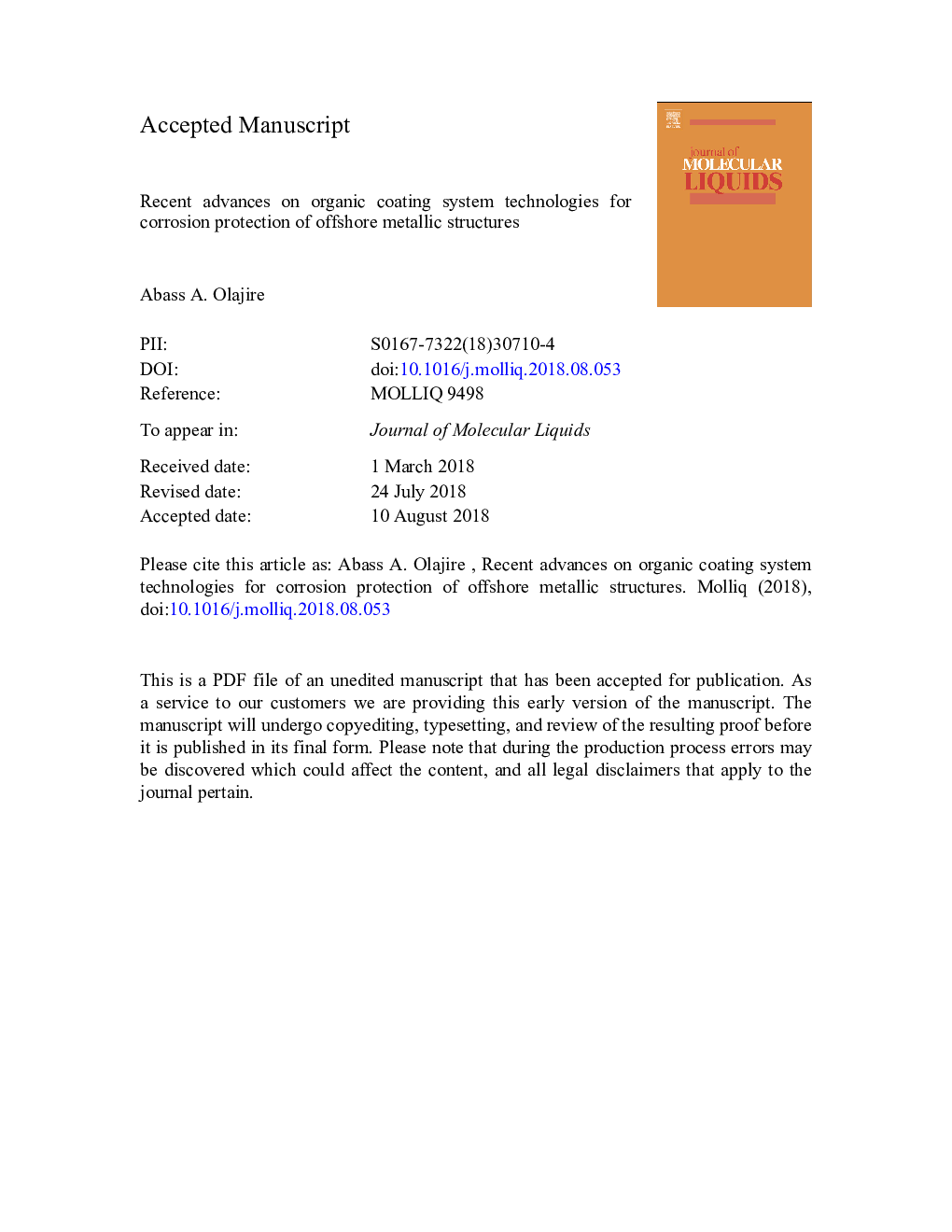| Article ID | Journal | Published Year | Pages | File Type |
|---|---|---|---|---|
| 7841581 | Journal of Molecular Liquids | 2018 | 102 Pages |
Abstract
Coatings for corrosion protection of metallic substrates such as steel, iron, magnesium, and aluminium, and their alloys have attracted tremendous interest in the offshore industry. Offshore facilities are prone to corrosion in various zones, ranging from atmospheric, splash, submerged and mud zones. Thus, there is high demand for prevention of corrosion of offshore facilities using organic coatings as potential replacements for the traditional coatings that are inefficient and expensive. This review highlights the latest developments in the corrosion protective performance of various types of organic coating systems. These coating systems are expected to provide barrier and active protection at varying degrees to offshore metallic structures in these corrosion zones. Thus, the utilization of organic coatings in complex and aggressive environmental conditions such as offshore, for efficient control of the initiation of metallic degradation, structural failures, and resource depletion is highly desirable by offshore industry to ensure safe and productive drilling operations. The effects of various loading systems on the performance of organic coatings are also discussed.
Keywords
PEIPVAPLGADSCPBSSDSTEOSNAPMTMSPCLEPCPDMSVOCsCNTSMBTTGAcpsEDAOCPPolypyrroleSECMSAMsMWCNTPSSTHFATRPEPSPPytetraethoxysilaneDCMFBECPODTAPEAMICLbLCRSSATSCPPPVQDADOPDCOITTBTTributyltinMMATDIGAGVEPpTHRCTHDIMDISKPPDPOIHEPEMPTSDibutyltin dilaurateSI-ATRPGPTMSDiglycidyl ether of bisphenol AAPTMSPDMAEMANEt3PBZTriethylenetetramineNSSTpoly(tetramethylene glycol)CuBrhexamethylene diisocyanateBIBBPSBMAPILDiazolidinyl ureaPDDAMTESWPUWater-borne polyurethaneDGEBAFDTSSCPsCold-rolled steelPoly (diallyldimethylammonium chloride)Surface-initiated atom-transfer radical polymerizationAniline trimerHMMMpurFH12MDIhmtetaPTMGDBTDLNAEPAPDPPSPMASelf-assembled nanophase particleMSNPsAPsdBSADFTh-BNPANISTPDifferential Thermal AnalysisEthylenediamineScanning kelvin probeCamphor sulfonic acidQuinaldic acidAtom transfer radical polymerizationAnisoleEpoxy esterEpoxyEpichlorohydrinGraphene oxideFunctionalized graphene oxideExopolysaccharidesCSAIsobornyl acrylateBtABetaineCopper bromideMetallic substratesBenzotriazoleTetrahydrofuranEISThermogravimetric analysisVolatile organic compoundstriethylamineSelf-assembled monolayersHydrogen evolutionScanning vibrating electrode techniqueSVETCorrosion protectionTETASMPdopamine hydrochlorideDichloromethanePotCVDChemical vapour depositionFouling-releasecrude palm oilsodium dodecyl sulfateSimulated concrete pore solutionBETShape memory polymerSAPAntifoulingElectrochemical impedance spectroscopySuperhydrophobicMild steelCarbon steelHot-dip galvanized steelLinear polarizationPotentiodynamic polarizationMTUPalm oil methyl esterMethyltrimethoxysilaneMethylmethacrylateMethyltriethoxysilaneMethylene diphenyl diisocyanateSEMCharge transfer resistanceSoy oilScanning electrochemical microscopyScanning electron microscopyCarbon black nanoparticlesHollow mesoporous silica nanoparticlesMultiwall carbon nanotubesCarbon nanotubesEmeraldine saltHexagonal boron nitrideNAPPHEMAOrganic-inorganic hybridMolecular weightCyclic voltammetricPAMAMEmeraldine baseammonium persulfatepoly(o-toluidine)Poly(butylene succinate)Poly(sulfobetaine methacrylate)Poly(phenylenevinylene)PMMAPoly(ε-caprolactone)PolyamidoaminePolyanilinePolyethyleniminepolythiophenePolystyrenesulfonatePolyesteramidepolymethyl methacrylatepolyvinyl alcoholpolybenzoxazineSuperabsorbent polymerconducting polymersPolyurethaneOrganic coatingsHybrid coatingsPOMEPEOTEADifferential scanning calorimetryWeight loss
Related Topics
Physical Sciences and Engineering
Chemistry
Physical and Theoretical Chemistry
Authors
Abass A. Olajire,
